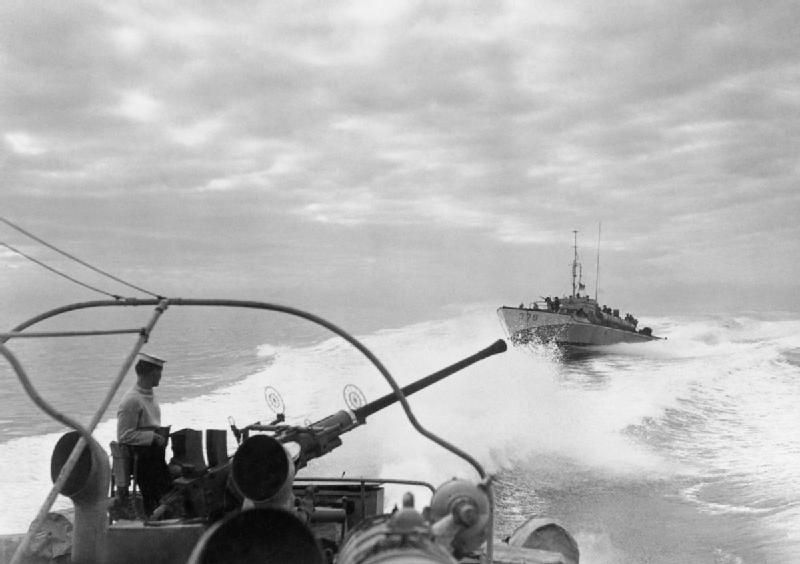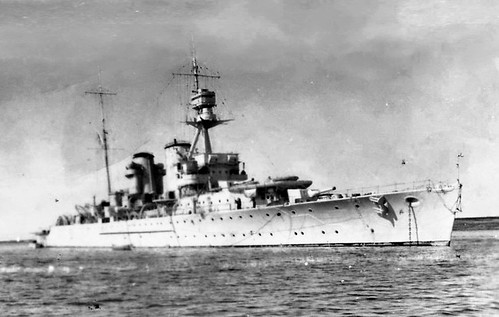In the Navy, You Can Have a Lot of Fun...
Disclaimer...
Just a quick reminder, these 'TOP 5' posts that I'm starting to do are not a list of what are generally perceived to be the best of whatever category I am writing about! These posts are MY personal (and probably biased) favourites! As such, these list are just my opinion and not open to discussion! (Though you may disagree and have your own opinion.)
My Top 5 Naval Assets
Anyway, now on with my list. But note that I've called this post 'naval assets' and not ships or craft or whatever. Truth be told, the navy and it's history is undoubtedly my weakest knowledge area and I'm not up on what makes a 'good' warship, especially these days, so I've widened the scope to include other naval weapon technologies which I am a bit more familiar with.
5. HMS HAWKINS (D86) 1915-1947 - UK
Having say what I just said, let's kick off my list with a ship. And as if to underline that these lists are my personal lists I've chosen HMS HAWKINS as the first of my favourites, simply because my uncle served on it!
Now, before you say 'that is very unspecific, illogical and shouldn't count' hear me out... British WW2 ships all seem to have an understated anonymity about them, in fact - in that strange British twisted thinking that a defeat is somehow more 'heroic' and character building than a victory - unless a ship was tragically sunk, like the Hood or Royal Oak or Ark Royal, most people cannot name a WW2 Royal Navy ship at all!
Yet, the Royal Navy's fleet of largely unknown warships ALL contributed in their modest ways to the cumulative Allied victory and each had their own moment of heroism or interesting part to play. My uncle's ship is typical of this, in that who has heard of HMS HAWKINS? It wasn't a great battleship, in fact it was something of a outdated and outclassed vessel that the German navy - I'm sure - might have sneered at as being antiquated when compared to their modern warships.
Think on this though - and again, bear in mind that practically nobody has heard of this ship - HMS Hawkins in 1941 Hawkins began escorting convoys off the West African coast, rescuing nine survivors from the oil tanker British Premier, which had been torpedoed off Freetown by the German submarine U-65.
 |
| Above: At anchor, 1942. Source: Wikipedia |
OK, pretty standard stuff at the time I dare say, but shortly after - during the British invasion of Italian Somaliland -Hawkins captured five Italian merchant ships totalling 28,055 tons!
But, my favourite mission that the Hawkins took on was it's contribution to the Western Task Force Gunfire Support Bombardment Force U to support American troops landing at Utah Beach. On 6 June, the ship bombarded the coastal artillery positions in Grandcamp-Maisy and Saint-Martin-de-Varreville with some effect.
She was broken up in 1947.
4. VOSPER MOTOR TORPEDO BOAT - UK
Navy enthusiasts all have their particular favourite type of vessel, some like the great war wagons that are battleships, others the sleek and ubiquitous destroyers, and some like submarines. But of all the navy's vast array of craft I have always had a soft spot for the motor torpedo boat!
As a kid these fast boats often appeared in my go-to comic - 'Commando' - and always told a story of guts, glamour and glory as they small craft took on a David and Golith struggle against bigger enemies and won! Obviously, having grown up I realise that these kids stories don't paint a true story of the terrific job the Royal Navy's MTBs did during the war, and these days I turn to books like Douglas Reeman's 'Torpedo Run' for my attack boat fiction!
There's just something fascinating about these small naval vessels - and their US equivalent, the PT boat - that gives me a fantastic buzz. I really can't explain what it is about them. Maybe it's the speed, the job they did or that I have a piquant for machinegun turrets.
But, in any case, I do know that I like the idea that despite their size they could foil some of the enemy's larger ships with a well placed torpedo! (Blame my opinion on this ability being far too heavily influenced by the movie 'They Were Expendable' (1945) with John Wayne).
Sadly, there wasn't despite the British film industry being able to produce some excellent wartime naval movies - like the 'Cruel Sea' (1953) and 'In Which We Serve' (1942) - but no cinematic adaption of a MTB story.
So, I had to rely on Hollywood to give me my fast boat fix - despite the fact that the Americans never met the ultimate fast boat nemesis of WW2 - the infamous German E-Boat or Schnellboot! It was the threat that these powerful and deadly craft posed that caused the Royal Navy created its MGB force and later developed better-matched MTBs like the Vosper.
 |
| Above: MTBs in the Mediterranean, February 1945. Source: Wikipedia |
3. LVT-2 BUFFALO - USA
Let's not forget about The Marines! You'll understand, now, why I said my top naval assets rather than my top ships! This is the one non-shippy type
The LVT series - collectively known as the Buffalo was a major innovation at the time, and as we all know that necessity if the mother of invention, WW2 produced a great many inventions!
Now, while we European probably recognise this unusual 'craft'/vehicle but associate it with D-Day, that is because we tend to forget that America's more immediate concern was it's campaign in the Pacific.
_approach_Iwo_Jima;fig14.jpg) |
| Above: LVT-4 approaches Iwo Jima. Thus is not only a really impressive photo but also one which highlights the forgotten scale of the Pacific conflict. Source: Wikipedia |
People (even some Americans) tend to forget about the huge theatre of the Pacific campaign. But, as I say, this was America's primary focus as they were more immediately and actually on the defensive at the start of their entry into World War 2.
Amphioxus landings were - by nature of the so-called 'island hoping' warfare that was going on against Japan - a crucial means if America were to defeat the Japanese. So, naturally, a lot of thought was given to how best to get Marines and the Army ashore in what could be (and was) very hotly contested landings.
The LVTs saw their first operational use in Guadalcanal in 1942 and while - initially - they were used to land supplies it became evident , through hard fought experience, that the LVTs could provide protected transportation for landing operations. Through a process of trial by fire, the LVT steadily evolved - after a complete redesign of the original LVT - into the LVT-2 Buffalo.
Factoid: I, like many people, tend to think of the US Pacific campaign as one mostly carried out by the Marine Corps, but in actuality the US Army was very heavily involved as well.
 |
| Above: As usual my choice of favourite military assets has a lot to with what scale models I really like or have built in the past. The AIRFIX Buffalo & Willys Jeep set is a vintage classic. |
Anyway, as it turned out, the Pacific campaign and the lessons learned there were an ideal proving ground for when - eventually - the Allies invaded and liberated mainland Europe.
Why I like the LVT-2 Buffalo? Well, first of all, the design was a piece of genius which - in my humble opinion - matched the much vaunted and more famous British 'Funnies' that helped win the D-Day campaign in 1944. Also, if you have ever watched the beach landing scene in 'Saving Private Ryan' you will appreciate what a deadly and costly activity it was landing troops using the conventional landing craft.
It was OK landing craft getting troops to a beach, but getting them up the beach was quite another thing. What I'm saying is the LVTs saved a LOT of lives and were crucial to the eventual Allied victories in both the Pacific and European theatres. Though, ironically, the US Army was sceptical about the usefulness of the Buffalo...Though hindsight is a wonderful thing
I think the Buffalo is a real unsung hero.
2. Short Sunderland - The 'Flying Porcupine'.
Again, not a ship! 😄 But I think we all understand the important part that aircraft played in maritime operations, particularly during World War 2. From reconnaissance to anti-submarine, to transport and rescue, to fleet protection and attack, aircraft became a huge part of the navy's operations and the aircraft carrier overtook the battleship as the number 1 naval weapon.
But, while we tend to think of carrier-borne aircraft when it comes to naval operations it is somewhat overlooked how many maritime air operations were undertaken from land. Britain's RAF Coastal Command had the responsibility of protecting of Allied convoys from attacks by the German Kriegsmarine's U-boats. It also protected Allied shipping from aerial attacks by the Luftwaffe.
In doing so Coastal Command employed a great variety of aircraft types; from the smaller twin-engined patrol 'bomber' types like the Avro Anson and Lockheed Hudson to the heavy bombers like the Consolidated Liberators and Handley Page Halifax (to name but a few types flown). But, of all the interesting aircraft that protected our seas (and fought around the world's oceans) the Coastal Command flew one very unique type that went on to earn itself almost legendary status and - apparently - struck fear into the hearts of it's German opponents... The Short Sunderland 'flying boat'!
 |
| Above: Short Sunderland Mk V ExCC. Just beautiful and very intimidating! Source: Wikipedia |
I could tell you about the sterling and important roles that the Sunderland played - particularly against the German U-Boat threat and protecting Atlantic convoys - but what piques the most interest in this aircraft was it's formidable reputations that earned itself the nickname of the 'Flying Porcupine'!
The Sunderland could be armed with a whopping 12 × 0.303 in (7.7 mm) Browning machine guns, which made any encounter with it a very prickly one (see what I did there 😆)!
As a lad this 'armed to the teeth' flying boat real caught my imagination, especially when one reads about some of the 'poor' Germans who tried to get the best of it, as in this particular occasion...
"The type's capacity to defend itself was demonstrated in particular by an air battle over the Bay of Biscay on 2 June 1943, when eight Junkers Ju 88Cs attacked a single Sunderland Mk III...The Sunderland survived and claimed three Ju 88s destroyed." Amusingly and quite aptly this aircraft's call sign was "N for Nuts"! (It's worth reading the full combat report as it's ripping stuff! Link: Wikipedia entry for the Sunderland, opens in new window.)
 |
| Above: Guns everywhere! A couple of the Sunderland dorsal 'quills'! Ouch! Source: Wikipedia |
1. 'Sea Pigs' - Italian 'Human Torpedoes'!
And finally. When one thinks of World War 2 there is one nation - in particular - that always gets a very bad wrap, and that's poor old Italy. We've all heard the jokes, being British we have a nasty habit of belittling other nation's militaries in order to big up our own. But, to be fair, Britain - especially in WW2 - had it's fair share of ignominious and embarrassing moments, we just turn them into 'glorious and heroic defeats'!
With Italy though, it does not help that their major ally - Germany - had a habit of jumping aboard the bandwagon and voicing it's own negative opinions about the quality of the Italians.
Luckily, over time and with the interest in historical research Italy and things Italian during this period have been somewhat reappraised and some of the positives about their role in WW2 are being accepted. Whether that be some of their excellent small arms, some of their world class aircraft, units like their famous and excellent Paracadutisti (paratroopers) or thier navy!
Yes, The Regia Marina also suffers from the stigma which dogs Italy, and - to be fair - this poor reputation stems not from it's ships or men but from it's poor leadership and choices that it made in conducting the war.
The fact is, the Italian navy had some of the most modern and well designed vessels of the time - in particular, some excellent battleships - and it may surprise you to know that they were also world leaders in one particular aspect of naval warfare...
The Italians were highly respected and effective 'frogmen'! To such an extent, in fact, that even the snooty Germans respected them!
The Decima Flottiglia MAS (Decima Flottiglia Motoscafi Armati Siluranti, also known as La Decima or Xª MAS) (Italian for "10th Assault Vehicle Flotilla") was an Italian flotilla, with marines and commando frogman unit, of the Ialian Navy...
Decima MAS was active during the Battle of the Mediterranean and took part in a number of daring raids on Allied shipping. These operations involved surface speedboats (such as the raid on Souda Bay), human torpedoes (the raid on Alexandria) and Gamma frogmen (against Gibraltar). During the campaign, Decima MAS took part in more than a dozen operations which sank or damaged five warships (totalling 72,000 tons) and 20 merchant ships (totalling 130,000 GRT). [Source: Wikipedia.]
As elite as the Italian frogmen were, perhaps the most dangerous and fascinating of their innovative practises was the use of 'Siluro a Lenta Corsa' (SLC), also known as Maiale (pig) which were - in essence - human torpedoes'!
The mere fact that a military deploys something called a 'human torpedo' has to make you pay attention! And the Italian frogmen really did carve out a formidable reputation for undertaking operations that no one believed or considered were possible.
My father served in North Africa in World War 2, and despite him not being above repeating the usual uncomplimentary opinions about the quality of the Italian army, he did mention just how shocked the British were about the Italian frogmen attack at Alexandria. It was - it seemed - a real blow to British morale at the time.
 |
| Above: I mean, would YOU get on one of these things? It takes a lot of guts to do so. Manned torpedo, called Maiale, at the Museo nazionale della scienza e della tecnologia Leonardo da Vinci of Milan. Source: Wikipedia |
I'll end with this final complement about these brave Italians. They say that imitation is the sincerest form of flattery, so in 1942 - after the Alexandra raid - The Royal Navy created (copied) the Italian design to make it's own version of the manned torpedo, which they called the Chariot.
In something of a revenge attack, in 1943 a number of Chariots launched from the submarines HMS Thunderbolt and HMS Trooper attacked and sank the Italian Capitani Romani-class cruiser the Ulpio Traiano in Palermo harbour, and severely damaged the Italian troop ship, a former ocean liner, Viminale.




Post a Comment